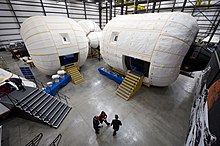毕格罗宇航
外观
| 毕格罗宇航 | |
|---|---|
| 公司类型 | 私人公司 |
| 成立 | 1999年 |
| 创办人 | 罗伯特·毕格罗 (创始总裁) |
| 代表人物 | 罗伯特·毕格罗, Blair Bigelow[1] |
| 总部 | |
| 产业 | 航太 |
| 产品 | 轨道舱室, 商业太空 |
| 员工人数 | 150人 (2018年12月)[2] |
| 网站 | bigelowaerospace |
毕格罗宇航或比奇洛航天公司(Bigelow Aerospace)是一间位于美国内华达州北拉斯维加斯的太空技术创业公司,正在建造可充气式太空站。毕格罗宇航由罗伯特·毕格罗于1998年成立[3],资金在很大程度上是由毕格罗以旅店业者的身份积累财富而来。毕格罗先生的愿景是在宇宙中开启第一间酒店,也是宇航公司成立的最终目的。

直至2010年,毕格罗已为公司投资1.8亿美元[4]。毕格罗曾在多个场合表示,他准备资助毕格罗宇航约5亿美元到2015年,以实现推出全面的硬件[3][5]。2013年初,比格罗航天公司与美国航空航天局签署协议,于2013年年底之前,国际空间站上将测试由比格罗公司提供的微型模拟可充气式太空舱,进行可行性质检验。若通过,准备于2020年发射大型的可充气式太空舱与国际空间站连接,供空间站内宇航人员使用,直至2024-2028年国际空间站寿命结束为止[6]。

组件设计和商业计划
[编辑]公司正在开发一系列的原型和生产空间站组件,包括:
- 创始一号,一个三分之一大小的原型于2006年7月12日发射,重约3000磅(1,360公斤),尺寸约为14.5英尺(4.4米)乘5.25英尺(1.6米)。[7]
- 创始二号,与创始一号相同大小,加入其他系统进行测试和发送付费会员的物品。发射于2007年6月28日。[8]
- BA 330,一个完整大小的组件,满载时重约50000镑(23,000公斤),尺寸为约45英尺(13.7米)乘22英尺(6.7米)。[9]
| 组件类型 | 组件名称 | 发射日期 | 发射火箭 | 状态 |
|---|---|---|---|---|
| 创始探路者 | 创始一号 (Genesis I) |
2006年7月12日 14时53分30秒(UTC) |
第聂伯 | 发射成功,在轨道中[10] |
| 创始二号 (Genesis II) |
2007年6月28日 15时02分00秒(UTC) |
第聂伯 | 发射成功,在轨道中[11] | |
| 银河号 (Galaxy) |
已取消 | 已取消发射,进行过地面测试[12] | ||
| 太阳舞者 (Sundancer) |
已取消 | 已取消 | ||
| BA 330“鹦鹉螺号” (Nautilus) |
2014年-2015年 | 设计中;模拟舱测试中 | ||
| BA 2100“奥林匹斯号” (Olympus) |
初步规划中 | 初步规划中 | ||
参考资料
[编辑]- ^ https://twitter.com/BlairBigelow
- ^ 存档副本. [2020-02-09]. (原始内容存档于2020-02-11).
- ^ 3.0 3.1 Bigelow's Gamble (页面存档备份,存于互联网档案馆) Aviation Week & Space Technology, 2004-09-26, reprint (authorized), accessed 2010-02-17.
- ^ The Americans may still go to the moon before the Chinese (页面存档备份,存于互联网档案馆), The Economist, 2010-02-18, accessed 2010-03-04.
- ^ Mr. B's Big Plan (页面存档备份,存于互联网档案馆), Geoffrey Little, Air & Space Magazine, 2008-01-01, accessed 2010-02-18
- ^ “比格罗航天公司为国际空间站提供可充气式太空舱”,《载人航天》,2013年,第一期
- ^ Out There - Genesis I. BigelowAerospace.com. [2007-03-31]. (原始内容存档于2007-03-17).
- ^ Genesis II. (原始内容存档于2009-10-05).
- ^ David, Leonard. Bigelow Aerospace to Tackle Inflatable Space Habitats. Space.com. 2004-05-24 [2011-02-09]. (原始内容存档于2009-06-05).
- ^ David, Leonard. Bigelow Orbital Module Launched into Space. Space.com. 2006-07-12 [2007-03-11]. (原始内容存档于2006-07-12).
- ^ Malik, Tariq; and Leonard David. Bigelow's Second Orbital Module Launches Into Space. Space.com. 2007-06-28 [2007-06-29]. (原始内容存档于2007-07-18).
- ^ Special Announcement From Robert T. Bigelow (新闻稿). Bigelow Aerospace. 2007-08-13 [2010-05-03]. (原始内容存档于2008-03-31).
This dramatic rise in launch costs has forced us to rethink our strategy with Galaxy. Due to the fact that a high percentage of the systems Galaxy was meant to test can be effectively validated on a terrestrial basis, the technical value of launching the spacecraft - particularly after the successful launch of both Genesis I and II - is somewhat marginal. Therefore, we have decided to expedite our schedule yet again, and are now planning to move ahead directly with Bigelow Aerospace's first human habitable spacecraft, the Sundancer.
参阅
[编辑]外部链接
[编辑]- (英文)比格罗航天公司官方网站 (页面存档备份,存于互联网档案馆)


